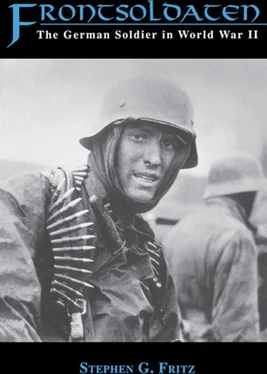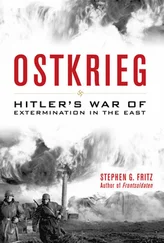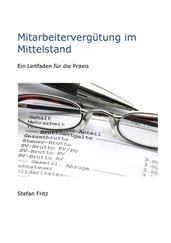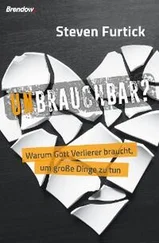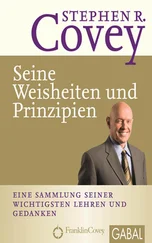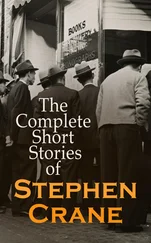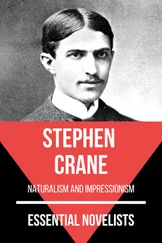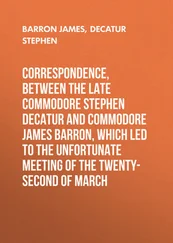20. Letters of anonymous corporal (10 July 1941), Private M.M. (20 Aug. 1941), and Corporal W.F. (17 Nov. 1941), in Buchbender and Sterz, Andere Gesicht, pp. 74 no. 104, 78 no. 116, 86–87 no. 143; letters of Karl Fuchs (4 Aug. and 12 Nov. 1941), in Richardson, Sieg Heil!, pp. 124, 157.
21. Fallnbigl quoted in Bartov, Hitler’s Army, pp. 155–56; letters of anonymous soldiers, in Dollwet, “Menschen im Krieg,” p. 286; letters of Captain E.P. (15 Feb. 1943), Corporal H.H. (12 June 1943) and Corporal H.G. (24 Sept. 1941), in Buchbender and Sterz, Andere Gesicht, pp. 113–14 no. 203, 117–18 no. 216, 82 no. 128.
22. Diary entry (Sept. 1943), in Prüller, Diary, p. 166; Paul Lenz, Reinhold Mahnke, Heinrich Sachs, and Hans Kondruss quoted in Bartov, Hitler’s Army, pp. 160–61.
23. Letter of anonymous soldier (24 Sept. 1939), in Dollwet, “Menschen im Krieg,” p. 309; letters of Lieutenant H.C. (7 July 1944) and Corporal F.K. (14 Aug. 1942), in Buchbender and Sterz, Andere Gesicht, pp. 173 no. 355, 172 no. 353.
24. Letter of Corporal H.K. (22 July 1942), in Buchbender and Sterz, Andere Gesicht, p. 172 no. 352. It is interesting to note that during the war Hitler constantly, and mistakenly, referred to his famous prophecy as having been made on 1 Sept. 1939 and not, as was the actual case, on 30 Jan. 1939. It was on 1 Sept., of course, that the German attack on Poland inaugurated World War II, but in Hitler’s mind—as well as in the letter quoted—that date also seemed to mark a declaration of war against the Jews of Europe.
25. Hitler quoted in Keegan, Second World War, p. 186; Reichenau and Manstein orders in Klee and Dressen, Gott mit Uns! pp. 39–42; Bartov, Hitler’s Army, pp. 128–31; Guderian quoted in Poliakov and Wolf, Dritte Reich, pp. 450–58.
26. Letter (16 Jan. 1945), in Prüller, Diary, p. 177; Poliakov and Wolf, Dritte Reich, pp. 398–416; Bartov, Eastern Front, p. 83 (see generally pp. 68–105); Bartov, Hitler’s Army, pp. 132–37; Messerschmidt, Die Wehrmacht im NS-Staat, pp. 441–80; monthly report of Feldpostprüfstelle, Pz.AOK.3 (2 Sept. 1944), in Buchbender and Sterz, Andere Geischt, p. 22.
27. Letter of Egon Freytag (28 Aug. 1941), in Bähr and Bähr, Kriegsbriefe, p. 150; diary entry(3 Oct. 1941), in Prüller, Diary , p. 110; letter of Lieutenant P.G. (1 Feb. 1943), in Buchbender and Sterz, Andere Gesicht, p. 105 no. 181; Schneider and Gullans, Last Letters, pp. 50–51; article (Dec. 1942), in Prüller, Diary, pp. 160–62.
28. Bartov, Hitler’s Army, p. 133; letters of Corporal W.P.C. (4 Aug. 1944) and Lieutenant K.N. (31 Aug. 1944), in Buchbender and Sterz, Andere Gesicht, pp. 154–55 no. 314, 157–58 no. 322; Grupe, Jahrgang 1916, pp. 280, 281, 284.
29. Sajer, Forgotten Soldier, pp. 216–18, 291.
30. Letter of Lieutenant J.H. 25 Oct. 1941), in Buchbender and Sterz, Andere Gesicht, p. 85 no. 138; Diary entry (21 July 1941), in Prüller, Diary, pp. 84–85.
31. Letters of Karl Fuchs (17 July, 15 Aug., and 20 and 15 Oct. 1941), in Richardson, Sieg Heil! pp. 119, 125–26, 146–47, 144.
32. Letters of Private H. (9 July 1941), Corporal W.F. (22 Aug. 1941), and Sergeant H.S. (21 Sept. 1941), in Buchbender and Sterz, Andere Gesicht, pp. 73 no. 103, 79 no. 118, 80–81 no. 125; letter of anonymous soldier (29 Sept. 1943) in Dollwet, “Menschen im Krieg,” p. 303; anonymous soldier quoted in Lucas, War on the Eastern Front, pp. 34–35.
33. Letter of Harry Mielert (30 Nov. 1942), in Mielert-Pflugradt, Russische Erde, p. 40; Malaparte, Volga Rises in Europe, p. 119; Erich Dwinger quoted in Clark, Barbarossa, p. 146.
34. Diary entry (4 July 1941), in Prüller, Diary, p. 75; letters of Corporal L.K. (29 Oct. 1941) and Corporal H.H. (15 Oct. 1941), in Buchbender and Sterz, Andere Gesicht, pp. 85 no. 139, 84 no. 135; anonymous soldier quoted in Bartov, Hitler’s Army, p. 158; letter of Karl Fuchs (3 Aug. 1941), in Richardson, Sieg Heil! p. 122.
35. Bartov, “Conduct of War,” pp. S36-S37. In his earlier works, Bartov downplayed the whole notion of primary group loyalty and comradeship as an explanation for the resilience of the German soldier, asserting that the enormous losses suffered on the eastern front must have destroyed any such cohesion. He emphasized instead the role of Nazi propaganda, indoctrination, and ideology in creating a formidable fighting force. See, e.g., Bartov, Eastern Front, Bartov, “Extremfälle der Normalität”; Bartov, “Daily Life and Motivation in War,” pp. 200–14; Bartov, “Von unten betrachtet,” pp. 326–44; Bartov, “Soldiers, Nazis, and War,” pp. 44–60; Bartov, Hitler’s Army. Without disputing the role of ideology (indeed, I agree with its importance), I believe that Bartov overlooked or minimized the impact of more positive ideals such as that of Volksgemeinschaft in motivating German troops, an oversight perhaps partially addressed in his article “The Conduct of War,” esp. pp. S36-S37.
36. Martin Broszat, “National Socialism,” pp. 136–40; Eksteins, Rites of Spring, pp. 90, 93–94, 118; Vansittart, Voices from the Great War, pp. 21, 67. See also Mosse, Fallen Soldiers.
37. Rilke quoted in Eksteins, Rites of Spring, p. 193; Zweig and Hitler quoted in Vansittart, Voices from the Great War, pp. 27, 261; Bartov, “The Missing Years,” p. 51.
38. Eksteins, Rites of Spring, p. 257; Stern, “National Socialism as Temptation,” pp. 147–57; J. O’Neill, German Army, pp. 67–68; Eksteins, Rites of Spring, pp. 297, 303, 309, 324.
39. Ley quoted in Mosse, Fallen Soldiers, p. 167; on the myth of the new man generally, see pp. 64–65, 78–80, 166–69, 182–85, 208–11. See also Hüppauf, “Langemarck,” p. 78; Herf, Reactionary Modernism, pp. 37, 38 n. 57; Lane, “Nazi Ideology,” p. 23.
40. On the issues of the Nazi social revolution and the debate over whether Nazism promoted a modernization of Germany, see Schoenbaum, Hitler’s Social Revolution; Dahrendorf, Society and Democracy in Germany, Peukert, Inside Nazi Germany; Zitelmann, Hitler, Prinz, Vom neuen Mittelstand; Prinz and Zitelmann, Nationalsozialismus und Modernisierung; Harlander and Fehl, Hitlers sozialer Wohnungsbau; Smelser, Robert Ley; Smelser, “How ‘Modern’ were the Nazis?” pp. 285–302; Gispen, “National Socialism and the Technological Culture,” pp. 387–406; Mason, Sozialpolitik im Dritten Reich, Mason, Social Policy in the Third Reich; Stephenson, “Modernization, Emancipation, Mobilization”; Childers and Caplan, Re-Evaluating the Third Reich; Alber, “Nationalsozialismus und Modernisierung”; Turner, “Fascism and Modernization”; Aly and Heim, Vordenker der Vernichtung; Aly and Heim, “Die Ökonomie der ‘Endlösung’; Browning, “German Technocrats, Jewish Labor, and the Final Solution”; Burleigh and Wippermann, The Racial State.
41. Schoenbaum, Hitler ‘s Social Revolution, pp. 247–49; Hitler speech of 30 Sept. 1942 in Domarus, Hitler, p. 1922. See also Zitelmann, Hitler, pp. 122–45. On the modernizing aspects of the National Socialist revolution on the army, see Müller, “The Army and the Third Reich: An Essay in Historical Interpretation,” in his Army, Politics, and Society, pp. 16–53; O’Neill, German Army, esp. chap. 5, “The Army and Party Ideology,” pp. 62–83.
Читать дальше
